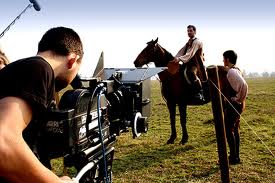 I’ve always enjoyed practicing my guitar while watching TV and trying to imitate various things from the music. I often noticed some familiar guitar parts and grooves used in various shows and TV ads and think to myself “hey, that sounds like something I could write in my studio, … how does a person get into this business of licensing their music for film and TV? Sign me up!” As with most other things in life, sometimes you need a spark of inspiration to move you from dreaming about doing something to actually doing it. In 2010 I was lucky enough to attend South-by-Southwest in Austin as part of my day job in the software business. For those who haven’t attended SXSW, it’s a combination of 3 overlapping conferences: an independent film festival, an interactive technology conference, and a music showcase for indie recording artists. It’s a great place to meet all kinds of creative people in addition to seeing a slew of up-and-coming bands from all over the world, invading downtown Austin to play their hearts out. In between my job duties as demo boy for our company’s booth at the show, I attended numerous sessions about the music industry including panel sessions about composing for film and TV (only a pipe dream in my life up to this point, I had no idea even where to start). Attending those sessions had a major inspirational effect on me, lighting the spark that started my crazycomposer blog site and sent me on a quest to become one of those people who make music for TV and film. Being around all of
I’ve always enjoyed practicing my guitar while watching TV and trying to imitate various things from the music. I often noticed some familiar guitar parts and grooves used in various shows and TV ads and think to myself “hey, that sounds like something I could write in my studio, … how does a person get into this business of licensing their music for film and TV? Sign me up!” As with most other things in life, sometimes you need a spark of inspiration to move you from dreaming about doing something to actually doing it. In 2010 I was lucky enough to attend South-by-Southwest in Austin as part of my day job in the software business. For those who haven’t attended SXSW, it’s a combination of 3 overlapping conferences: an independent film festival, an interactive technology conference, and a music showcase for indie recording artists. It’s a great place to meet all kinds of creative people in addition to seeing a slew of up-and-coming bands from all over the world, invading downtown Austin to play their hearts out. In between my job duties as demo boy for our company’s booth at the show, I attended numerous sessions about the music industry including panel sessions about composing for film and TV (only a pipe dream in my life up to this point, I had no idea even where to start). Attending those sessions had a major inspirational effect on me, lighting the spark that started my crazycomposer blog site and sent me on a quest to become one of those people who make music for TV and film. Being around all of

the creativity and energy of SXSW (along with the great Texas BBQ and friendly people) left me completely inspired to pursue my lifelong dream.

